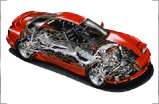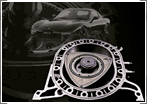|
|
| |
 |
|

The Third generation Mazda RX-7 debuted in 1992 as a 1993 model. Mazda marketed it as the "return of the pure sports car". Well, guess what? They weren't lying about it. The new RX-7 was lighter, faster, and more responsive. No compromises were made while Mazda was engineering this car. The result was a |
|
pure drivers car that could thrash on the track one day yet be driven the next day to work.
Mazdas used the definitive expression of Kansei Engineering which is Mazda's philosophy that emphasizes a total harmony between the driver and the car. Kansei Engineering harness all the latest supercomputers, yet still relies on the insight of people, on their feelings and emotions. The Third generation RX-7 was created for true driving enthusiasts by true driving enthusiasts. |
|
 |
Underneath every panel in the RX-7 has a story. Every curve in its body has a |
|
| reason for being and a reason for being that shape. Engineers from all disciplines and design areas met regularly during the design process to evaluate their colleagues' efforts, through six rounds of design. Even every member of the development team took special courses in high-performance driving. Because by driving cars at the limit, on the track, they could understand what seperates a merely competent sports car from a great one. |
|
With their experience and knowledge taken from high performance driving class. Mazda engineers were able to begin designing the RX-7 from the ground up with the intent of building a pure sports car. Visually, the RX-7 leaves no doubt as to its purpose, with its aggressive and timeless styling cues. The structure is strong and rigid, yet lightweight. Underneath the |
|
 |
|
| suspension is a work of art, deceptively simple in appearance yet supremely functional. The RX-7 dramatically defines high-performance sports car motoring. |
|
 |
Since its debut over 20 years ago, one major thing set the RX-7 apart from all |
|
| the other cars. The Rotary engine was that thing. Developed by Dr. Felix Wankel, the engine used a rotating rotor inside a housing instead of cylinders and pistons. The rotary enging makes an ideal powerplant for a sports car because it is compact and lightweight, yet powerful and durable. Part of the reasoning behind the durability is because of its simplicity. In the engine itself, there are only three primary moving parts, two rotors and one crankshaft. |
|
 |
|
The 13B - (engine code) in the RX-7 puts out 255 horsepower at 6500 rpm and has a resulting horsepower to weight ratio of 10.9:1. With 217ft-lb of torque at 5000 rpm. With all this the RX-7 is capable of doing zero to sixty in only 4.9 seconds reaching a top speed of 156 mph.
In creating the 13B engine that powers the RX-7, Mazda engineers drew upon 30 years of |
|
| rotary research, development, and refinement. Every major component - the intake system, exhaust system, coolant system, and electrical system - has been extensively modified or completely new. From the start, the engine was intended for turbocharging. With ports instead of valves and with a natural supercharging effect in normal operation, the rotary engine was an ideal candidate for turbo charging. So a sequential system was designed.
In Mazda's sequential arrangement, one turbo only supplies boost at lower rpm, receiving the full force of the exhaust so throttle response is instant. As revs climb the second joins in, giving the same high-rpm boost as a tandom design. To further increasre power, an intercooler cools the intake so that the turbo chargers can force more of it into the rotor chambers. The intercooler is located in the nose to get the benefit of a direct air stream. The turbos are housed close to the exhaust ports for maximum efficiency to ensure reliability the whole design has undergone torture testing, including similated continuous acceleration runs 24 hours a day for three months. Even the diferrential is out of the ordinary in the RX-7. Its a Gleason Torsen unit, an ingenious limited slip design. This provides handling advantages on slippery or uneven surfaces, which is widely used in race cars. No other car in the world offers you this kind of drivetrain.
In 1993, the RX-7 was Motor Trend's import car of the year and received great reviews from many car magazines. Sadly the RX-7 no longer graces our shores due to slow sales and because of Ford. Now why do I know all this??? Well its because I'm going to get one. Either a silver touring or R2. |
| |
|
©2003, Goospeed Designs, Inc. All
Rights Reserved. [ Disclamer
]
|
|
|
|